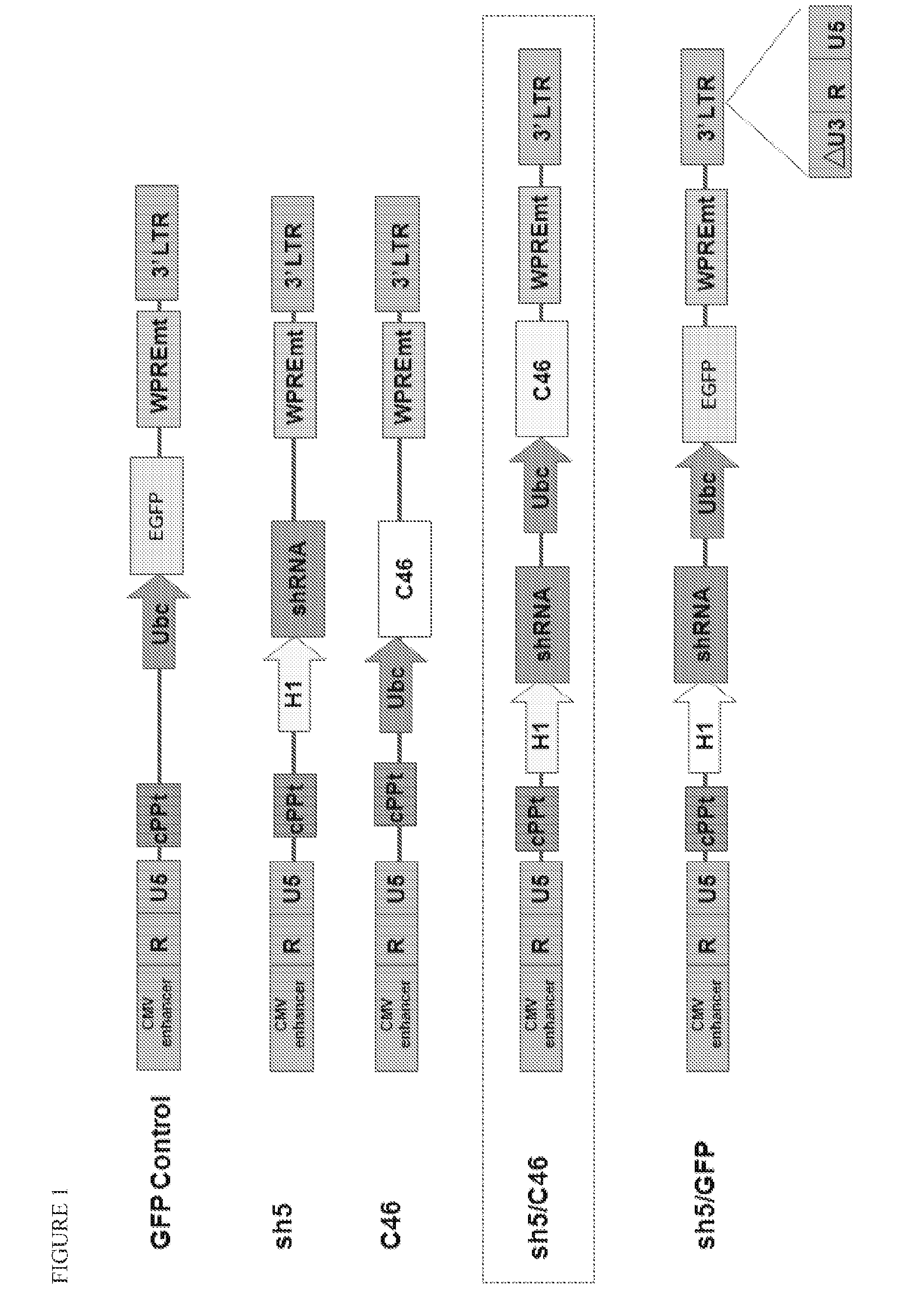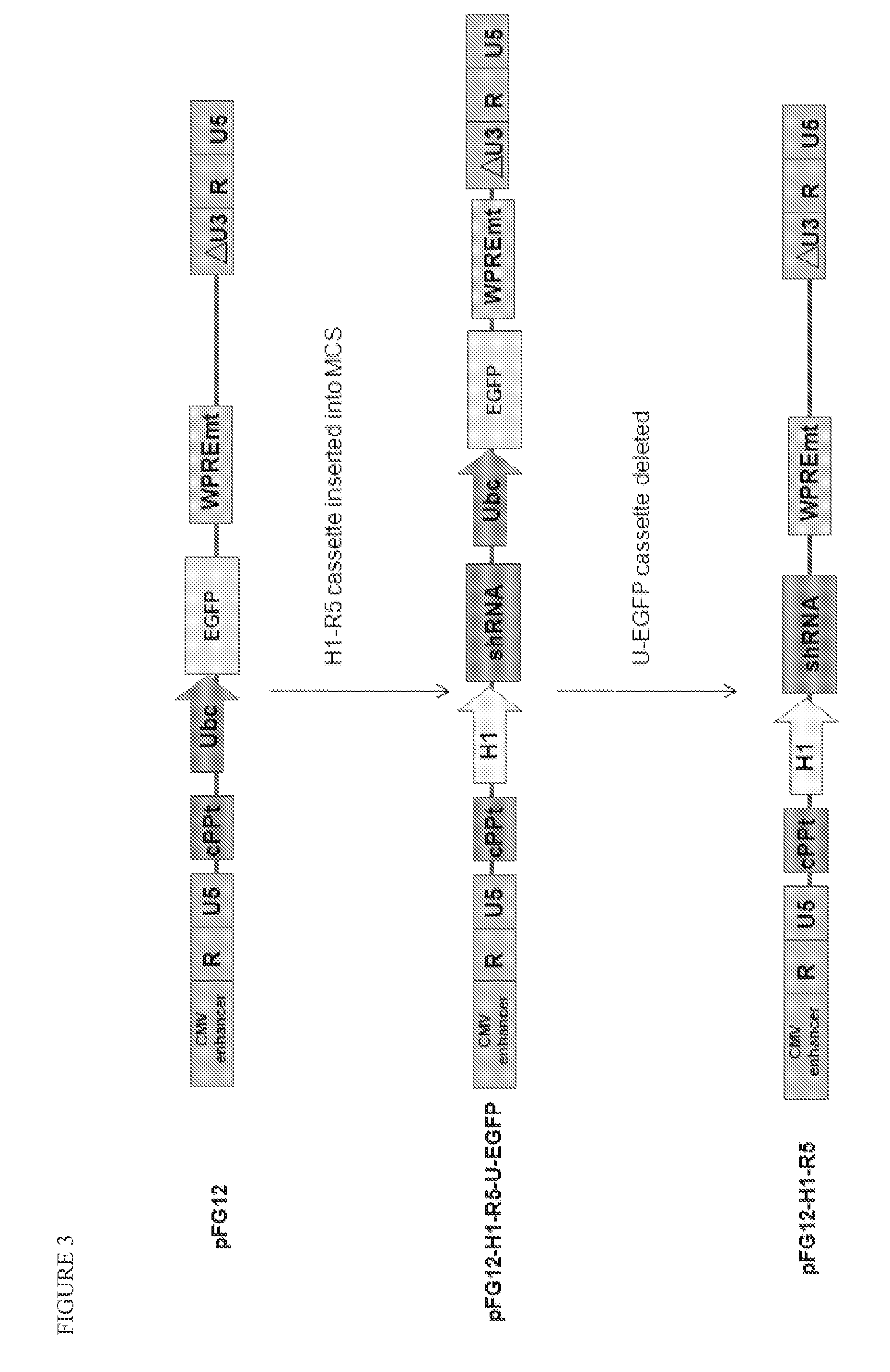Dual vector for inhibition of human immunodeficiency virus
a technology of human immunodeficiency virus and expression vector, which is applied in the field of molecular biology and virology, can solve the problems of increasing the probability of death due to opportunistic infections, increasing the probability of hiv/aids death, and not cured or completely eliminated all the symptoms of hiv/aids, and achieves the effect of reducing the nod scid-hu blt mous
- Summary
- Abstract
- Description
- Claims
- Application Information
AI Technical Summary
Problems solved by technology
Method used
Image
Examples
example 1
Construction of Dual Vector Containing shRNA Against CCR5 and C46 Fusion Inhibitor (sh5 / C46 Dual Vector) and Control Vectors with Single or no Therapeutic Inserts
A. Vector Plasmid Constructs
[0099]A variety of constructs were designed and engineered in the DNA form as plasmids. The constructs are summarized in Table 1 and illustrated in FIGS. 1-4. All of these constructs give rise to lentiviral vectors upon transfection into packaging cell lines (see section B below).
TABLE 1Description of Vector Plasmid ConstructsPlasmidConstructFull NameShort NameDescriptionpFG11F-U-GFP ControlControl single lentiviral vector (LV)EGFPcontaining ubiquitin promoterdriving EGFPpFG12-H1-R5sh5Single LV containing H1 promoterdriving shRNA against CCR5pFG11F-U-C46Single LV containing ubiquitinC46promoter driving C46pFG11F-H1-sh5 / C46Dual LV containing H1 promoterR5-U-C46driving shRNA against CCR5 andubiquitin promoter driving C46pFG12-H1-sh5 / GFPLV containing H1 promoter drivingR5-U-EGFP(also referredshRNA a...
example 2
Transduction of Human Target T Cell Lines by sh5 / C46 Dual Vector
[0157]The various lentiviral vectors described in Example 1 were used to infect CEM.NKR.CCR5 and Molt4 / CCR5 cells (NIH AIDS Reagent Program) cells. 2×105 cells were resuspended in 1 mL unconcentrated virus containing medium (VCM) with 10% FBS and 8 μg / mL polybrene. Cultures were incubated at 37° C. for 1.5 hours and a further 1 mL of growth media added (RPMI+10% FBS). Cells were analyzed by FACS analysis 4 days post transduction for C46 expression (by 2F5 antibody staining), CCR5 knockdown (by CD195 antibody staining), and GFP expression. Cells were kept in continuous culture for up to 8 weeks by passaging twice weekly.
[0158]Simultaneous expression of shRNA (detected by CCR5 knockdown) and C46 in transduced CEM.NKR.CCR5 and Molt4 / CCR5 cells is shown in FIG. 6 and FIG. 7, respectively. GFP expression was observed for the constructs containing EGFP (panels 1,3 from left to right); a reduction in CCR5 expression (e.g. down...
example 3
Transduction of Human Peripheral Blood Mononuclear Cells by sh5 / C46 Dual Vector
[0161]The various lentiviral vectors described in Example 1 were used to infect human peripheral blood mononuclear cells (PBMC) obtained from the Australian Red Cross Blood Transfusion Service. PBMC were isolated from buffy coats using Ficoll-plaque PLUS (GE Healthcare) followed by CD8 depletion using CD8+ Microbeads (Miltenyi Biotec) and a VarioMACS magnetic unit. CD8+ depleted PBMC were cultured for 48 hours in RPMI 1640 media supplemented with 20% FBS and 5 μg / mL phytohemagglutinin (PHA) (Sigma) at 2×106 cells / mL. Following 2 days PHA stimulation, cells in suspension were harvested, centrifuged at 200 g for 5 minutes and resuspended at 2×106 cells / mL in RPMI+20% FBS+10 U / mL recombinant human interleukin-2 (rhIL-2; Roche) for 4 hours prior to transduction.
[0162]To ascertain the preferred transduction method, PBMC were transduced with the sh5 / EGFP lentiviral construct using various conditions: 1× transdu...
PUM
| Property | Measurement | Unit |
|---|---|---|
| concentration | aaaaa | aaaaa |
| resistance | aaaaa | aaaaa |
| size | aaaaa | aaaaa |
Abstract
Description
Claims
Application Information
 Login to View More
Login to View More - R&D
- Intellectual Property
- Life Sciences
- Materials
- Tech Scout
- Unparalleled Data Quality
- Higher Quality Content
- 60% Fewer Hallucinations
Browse by: Latest US Patents, China's latest patents, Technical Efficacy Thesaurus, Application Domain, Technology Topic, Popular Technical Reports.
© 2025 PatSnap. All rights reserved.Legal|Privacy policy|Modern Slavery Act Transparency Statement|Sitemap|About US| Contact US: help@patsnap.com



